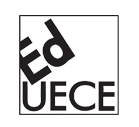Interactional Linguistics
DOI:
https://doi.org/10.46230/2674-8266-15-10084Keywords:
Linguística Interacional, Análise da Conversa, Sociolinguística InteracionalAbstract
O presente capítulo fornece um esboço da Linguística Interacional e sua relevância à Linguística Aplicada. Inclui-se nisso uma pesquisa acerca da emergência da Linguística Interacional, seus conceitos básicos e instrumentos metodológicos, perguntas de pesquisa e desafios futuros da Linguística Interacional, bem como sua contribuição à Linguística Aplicada. O capítulo termina com uma bibliografia de trabalhos citados e referências relevantes.
Downloads
References
ANTAKI, C.; LEUDAR, I. Recruiting the record: using opponents’ exact words in parliamentary argumentation. Text & Talk, v. 21, n. 4, p. 467-488, 2001. DOI: https://doi.org/10.1515/text.2001.008
ANTAKI, C.; BARNES, R.; LEUDAR, I. Diagnostic formulations in psychotherapy. Discourse studies, v. 7, n. 6, p. 627-647, 2005. DOI: https://doi.org/10.1177/1461445605055420
ATKINSON, J. M.; DREW, P. Order in court: The Organization of Verbal Interaction in Judicial Settings. London: Palgrave Macmillan, 1979. DOI: https://doi.org/10.1007/978-1-349-04057-5
AUER, P. The pre-front field in spoken German and its relevance as a grammaticalization position. Pragmatics, v. 6, n. 3, p. 295-322, 1996. DOI: https://doi.org/10.1075/prag.6.3.03aue
AUER, P. Online-Syntax - Oder: was es bedeuten könnte, die Zeitlichkeit der mündlichen Sprache ernst zu nehmen. Sprache und Literatur, v. 31, n. 1, p. 43-56, 2000. DOI: https://doi.org/10.30965/25890859-031-01-90000005
AUER, P. Syntax als Prozess. In: HAUSENDORF, H. Gespräch als Prozess. Linguistische Aspekte der Zeitlichkeit verbaler Interaktion. Tübingen: Narr, 2006. p. 95-124.
AUER, P.; GILLES, P.; PETERS, J.; SELTING, M. Intonation regionaler Varietäten des Deutschen. Vorstellung eines Forschungsprojekts. In: STELLMACHER, D. Dialektologie zwischen Tradition und Neuansätzen. Beiträge der Internationalen Dialektologentagung. Göttingen, 19.-21. Oktober 1998 (Zeitschrift für Dialektologie und Linguistik, Beiheft 109. Stuttgart: Steiner.) 2000, p. 222-239.
AUER, P.; DI LUZIO, A. The contextualization of language. Amsterdam/Philadelphia: John Benjamins Publishing, 1992. DOI: https://doi.org/10.1075/pbns.22
AUER, P.; DIRIM, I. Türkisch sprechen nicht nur die Türken. Berlin/New York: de Gruyter, 2012.
BAKER, C.; FIRTH, A.; EMMISON, M. Calling for Help: Language and Social Interaction in Telephone Helplines. Amsterdam/Philadelphia: John Benjamins, 2005. DOI: https://doi.org/10.1075/pbns.143
BARTH-WEINGARTEN, D. Zur (Aus-)Nutzung konzessiver Konstruktionen in Radio Interviews: eine qualitativ-quantitative Untersuchung zur Kontextabhängigkeit von Äußerungen. Gesprächsforschung: Online-Zeitschrift zur verbalen Interaktion, v. 4, p. 251-281, 2003. Disponível em: https://www.gespraechsforschung-ozs.de. Acesso em: 24 ago. 2007.
BARTH-WEINGARTEN, D. Fuzzy boundaries–Überlegungen zu einer Grammatik der gesprochenen Sprache nach konversationsanalytischen Kriterien. In: DEPPERMAN, A.; FIEHLER, R.; SPRANZ-FOGASY; T. Grammatik und Interaktion, Radolfzell: Verlag für Gesprächsforschung, 2006a. p. 67-93. Disponível em: https://www.gespraechsforschung-ozs.de. Acesso em: 24 ago. 2007.
BARTH-WEINGARTEN, D. parallel-opposition-Konstruktionen: Zur Realisierung eines spezifischen Ausdrucks der Kontrastrelation. In: GÜNTHNER, S.; IMO, W. Konstruktionen in der Interaktion. Berlin/New York: Mouton de Gruyter, 2006b. p. 153-179. DOI: https://doi.org/10.1515/9783110894158.153
BECKER-MROTZEK, M.; BRÜNNER, G. Angewandte Gesprächsforschung: Ziele—Methoden-Probleme. In: FIEHLER, R.; SUCHAROWSKI, W. Kommunikationsberatung und Kommunikationstraining: Anwendungsfelder der Diskursforschung. Opladen: Westdeutscher Verlag, 1992. p. 12-23. DOI: https://doi.org/10.1007/978-3-322-85086-7_1
BECKER-MROTZEK, M.; FIEHLER, R. Unternehmenskommunikation. Tübingen: Narr, 2002.
BILMES, J. Question delivery formats as a feature of interactional style in the 1992 vice-presidential debate. Research on Language and Social Interaction, v. 34, p. 151-181, 2001. DOI: https://doi.org/10.1207/S15327973RLSI34-2_1
BIRKNER, K. Subjektive Krankheitstheorien im Gespräch. Gesprächsforschung: Online- Zeitschrift zur verbalen Interaktion, v. 7, p. 152-183, 2006. Disponível em: https://www.gespraechsforschung-ozs.de. Acesso em: 24 aug. 2007.
BOOTH, S.; PERKINS, L. The use of conversation analysis to guide individualized advice to carers and evaluate change in aphasia: a case study. Aphasiology, v. 13, n. 4-5, p. 283-303, 1999. DOI: https://doi.org/10.1080/026870399402109
BRINKER, K.; ANTOS, G.; HEINEMANN, W.; SAGER, S. F. Text-und Gesprächslinguistik/Linguistics of Text and Conversation. Ein internationales Handbuch zeitgenössischer Forschung/An International Handbook of Contemporary Research. Halbband 2: Gesprächslinguistik. Berlin/New York: Mouton de Gruyter, 2001. DOI: https://doi.org/10.1515/9783110169188.2
BRÜNNER, G.; GÜLICH, E. Krankheit verstehen: interdisziplinäre Beiträge zur Sprache in Krankheitsdarstellungen. Bielefeld: Aisthesis, 2002.
BRÜNNER, G.; FIEHLER, R.; KINDT, W. Angewandte Diskursforschung. Opladen: Westdeutscher Verlag, 1999. DOI: https://doi.org/10.1007/978-3-663-07733-6
BYBEE, J. Frequency of use and the organization of language. Oxford: Oxford University Press, 2006. DOI: https://doi.org/10.1093/acprof:oso/9780195301571.001.0001
CLAYMAN, S. Reformulating the question: A device for answering/not answering questions in news interviews and press conferences. Text-Interdisciplinary Journal for the Study of Discourse, v. 13, n. 2, p. 159-188, 1993. DOI: https://doi.org/10.1515/text.1.1993.13.2.159
CLAYMAN, S.; HERITAGE, J. The News Interview: Journalists and Public Figures on the Air. Cambridge: Cambridge University Press, 2002. DOI: https://doi.org/10.1017/CBO9780511613623
CORRIN, J.; TARPLEE, C.; WELLS, B. Interactional linguistics and language development: A conversation ana- lytic perspective on emergent syntax. In: SELTING, Margret; COUPER-KUHLEN, Elizabeth. Studies in interactional linguistics, Amsterdam/Philadelphia: John Benjamins, 2001. p. 199-226. DOI: https://doi.org/10.1075/sidag.10.10cor
COUPER-KUHLEN, E. Prosody and sequence organization in English conversation: The case of a new beginning. In: COUPER-KUHLEN, E.; FORD, C. Sound patterns in interaction. Amsterdam/Philadelphia: John Benjamins, 2004. p. 335-376. DOI: https://doi.org/10.1075/tsl.62.17cou
COUPER-KUHLEN, E.; SELTING, M. Towards an interactional perspective on prosody and a prosodic perspective on interaction. In: SELTING, M.; COUPER-KUHLEN, E. Prosody in conversation: Interactional studies. Cambridge: Cambridge University Press, 1996. p. 11-56. DOI: https://doi.org/10.1017/CBO9780511597862.003
COUPER-KUHLEN, E.; SELTING, M. Introducing interactional linguistics. In: SELTING, M.; COUPER-KUHLEN, E. Studies in interactional linguistics. Amsterdam/Philadelphia: John Benjamins, 2001. p. 1-22 DOI: https://doi.org/10.1075/sidag.10.02cou
COUPER-KUHLEN, E.; THOMPSON, S. You know it's funny: Eine Neubetrachtung der “Extraposition” im Englischen. In: GÜNTHNER, Susanne; IMO, Wolfgang. Konstruktionen in der Interaktion. Berlin/New York: Mouton de Gruyter, 2006, p. 23-58. DOI: https://doi.org/10.1515/9783110894158.23
CROMDAL, J. “Can I be with?” Negotiating play entry in a bilingual school. Journal of pragmatics, v. 33, n. 4, p. 515-543, 2001. DOI: https://doi.org/10.1016/S0378-2166(99)00131-9
CUMMING, S.; ONO, Tsuyoshi. Discourse and grammar. In: VAN DIJK, T. Discourse as Structure and Process. Discourse Studies: A multidisciplinary introduction, London: Sage, v. 1, 1997. p. 112-137. DOI: https://doi.org/10.4135/9781446221884.n4
CZYZEWSKI, M. Mm hm tokens as interactional devices in the psychotherapeutic in-take interview. In: TEN HAVE, P.; PSATHAS, G. Situated order: Studies in the social organization of talk and embodied activities. Washington, D. C.: University Press of America, 1995. p. 73-89
DEPPERMANN, A. Gespräche analysieren. Eine Einführung in konversationsanalytische Methoden. Opladen: Leske und Budrich. 1999.
DEPPERMANN, A. Ethnographische Gesprächsanalyse: Zu Nutzen und Notwendigkeit von Ethnographie für die Konversationsanalyse. Gesprächsforschung: Online-Zeitschrift zur verbalen Interaktion, v. 1, p. 96-124, 2000. Disponível em: https://www.gespraechsforschung-ozs.de. Acesso em: 24 ago. 2007.
DEPPERMANN, A. Disrespecting: A conversational practice for the negotiation of status in juvenile peer-groups. In: NÉMETH, E. Pragmatics in 2000: Selected Papers from the 7th International Pragmatics Conference. Antwerpen: International Pragmatics Association, 2001. p. 156-164.
DEPPERMANN, A. Conversational interpretation of lexical items and conversational contrasting. In: SELTING, M.; HAKULIEN, A. Syntax and lexis in conversation. Studies on the use of linguistic resources in talk-in-interaction. Amsterdam/Philadelphia: John Benjamins, 2005. p. 289-317. DOI: https://doi.org/10.1075/sidag.17.15dep
DEPPERMANN, A. Construction Grammar–eine Grammatik für die Interaktion? In: DEPPERMANN, A.; FIEHER, R.; SPRANZ-FOGASY, T. Grammatik und Interaktion, Radolfzell: Verlag für Gesprächsforschung, 2006. p. 43-65. Disponível em: http://www.verlag-gesprachsforschung.de/2006/deppermann.htm. Acesso em: 15 jun. 2007.
DEPPERMANN, A. Grammatik und Semantik aus gesprächsanalytischer Sicht. In: Grammatik und Semantik aus gesprächsanalytischer Sicht. Berlin/New York: de Gruyter, 2007.
DEPPERMANN, A.; SPRANZ-FOGASY, T. be-deuten. Wie Bedeutung im Gespräch entsteht. Tübingen: Stauffenburg, 2002.
DREW, P. Strategies in the contest between lawyer and witness in cross-examination. In: LEVI, J.; WALKER, A. G. Language in the judicial process. Springer, Boston, MA, 1990. p. 39-64. New York/Washington: Plenum Press, 1990. p. 39-64. DOI: https://doi.org/10.1007/978-1-4899-3719-3_2
DREW, P.; HERITAGE, J. Analyzing talk at work: An introduction. In: DREW, P.; HERITAGE, J. Talk at Work. Cambridge: Cambridge University Press, 1992. p. 3-65.
EERDMANS, S.; PREVIGNANO, C.; THIBAULT, P. Language and interaction: discussions with John J. Gumperz. Amsterdam/Philadelphia: John Benjamins, 2003. DOI: https://doi.org/10.1075/z.117
FIEHLER, R. et al. Eigenschaften gesprochener Sprache. Tübingen: Narr, 2004.
FOLEY, W. Anthropological Linguistics: An Introduction. Oxford: Blackwell, 1997.
FORD, C. Grammar in interaction: Adverbial clauses in American English conversations. Cambridge: Cambridge University Press, 1993. DOI: https://doi.org/10.1017/CBO9780511554278
FORD, C.; FOX, B.; THOMPSON, S. The language of turn and sequence. Oxford: Oxford University Press, 2002.
FORD, C.; THOMPSON, S. Interactional Units in Conversation: Syntactic, Intonational and Pragmatic Resources. In: OCHS, E.; SCHEGLOFF, E.; THOMPSON, S. Interaction and grammar. Cambridge: Cambridge University Press, 1996. p. 134-184. DOI: https://doi.org/10.1017/CBO9780511620874.003
FORD, C.; WAGNER, J. Interaction-based studies of language. Special issue of Pragmatics, v. 6, n. 3, p. 277-456, 1996. DOI: https://doi.org/10.1075/prag.6.3
FOX, B. Discourse structure and anaphora: Written and conversational English. Cambridge: Cambridge University Press, 1987. DOI: https://doi.org/10.1017/CBO9780511627767
FOX, B.; HAYASHI, M.; JASPERSEN, R. Resources and repair: A cross-linguistic study of syntax and repair. In: OCHS, E.; SCHEGLOFF, E.; THOMPSON, S. Interaction and Grammar. Cambridge: Cambridge University Press, 1996. DOI: https://doi.org/10.1017/CBO9780511620874.004
FOX, B.; THOMPSON, S. Relative clauses in English conversation: Relativizers, frequency, and the notion of construction. Studies in Language, v. 31, n. 2, p. 293-326, 2007. DOI: https://doi.org/10.1075/sl.31.2.03fox
FRANKEL, R. From sentence to sequence: Understanding the medical encounter through microinteractional analysis. Discourse processes, v. 7, n. 2, p. 135-170, 1984. DOI: https://doi.org/10.1080/01638538409544587
FRANKEL, R. Talking in interviews: A dispreference for patient-initiated questions in physician-patient encounters. In: PSATHAS, G. Interaction Competence, Washington: University Press of America, v. 1, 1990. p. 231-262.
FRENCH, P.; LOCAL, J. Turn-competitive incomings. Journal of Pragmatics, v. 7, n. 1, p. 17-38, 1983. DOI: https://doi.org/10.1016/0378-2166(83)90147-9
GILL, V. T.; MAYNARD, D. On “labeling” in actual interaction: Delivering and receiving diagnoses of developmental disabilities. Social problems, v. 42, n. 1, p. 11-37, 1995. DOI: https://doi.org/10.1525/sp.1995.42.1.03x0453k
GILLES, P. Regionale Prosodie im Deutschen. Variabilität in der Intonation von Abschluss und Weiterweisung, Berlin/New York: de Gruyter, 2005. DOI: https://doi.org/10.1515/9783110201611
GOODWIN, C. The interactive construction of a sentence in natural conversation. In: PSATHAS, G. Everyday language: Studies in ethnomethodology, New York: Irvington Publishers, v. 97, 1979. p. 101-121.
GOODWIN, C. Conversational Organization: Interaction between Speakers and Hearers. New York: Academic Press, 1981.
GOODWIN, C. Co-constructing meaning in conversations with an aphasie man. Research on language and social interaction, v. 28, n. 3, p. 233-260, 1995. DOI: https://doi.org/10.1207/s15327973rlsi2803_4
GREATBATCH, D. Some standard uses of supplementary questions in news interviews. In: WILSON, J.; CROW, B. Belfast working papers in language and linguistics, Jordanstown: University of Ulster, v. 8, p. 86-123, 1986.
GREATBATCH, D. Aspects of topical organization in news interviews: The use of agenda-shifting procedures by interviewees. Media, Culture & Society, v. 8, n. 4, p. 441-455, 1986. DOI: https://doi.org/10.1177/0163443786008004005
GREATBATCH, D. On the management of disagreement between news interviewees. In: DREW, P.; HERITAGE, J. Talk at Work, 1992. p. 268-301.
GÜLICH, E.; SCHÖNDIENST, M.; SURMANN, V. (eds.). Wie Anfälle zur Sprache kommen. Psychotherapie und Sozialwissenschaft, v. 4, n. 02, p. 235-239. 2002.
GÜNTHNER, S.; IMO, W. Konstruktionen in der Interaktion. Berlin/New York: de Gruyter, 2006. DOI: https://doi.org/10.1515/9783110894158
GÜNTHNER, S.; KNOBLAUCH, H. Culturally patterned speaking practices-the analysis of communicative genres. Pragmatics, v. 5, n. 1, p. 1-32, 1995. DOI: https://doi.org/10.1075/prag.5.1.03gun
GUMPERZ, J. Discourse strategies. Cambridge: Cambridge University Press, 1982. DOI: https://doi.org/10.1017/CBO9780511611834
GUTHRIE, A. On the systematic deployment of okay and mmhmm in academic advising sessions. Pragmatics, v. 7, n. 3, p. 397-415, 1997. DOI: https://doi.org/10.1075/prag.7.3.06gut
HABSCHEID, S. Gesprächsberatung in Organisationen und Institutionen. In: KNAPP, K.; ANTOS, G.; BECKER-MROTZEK, M.; DEPPERMANN, A.; GÖPFERICH; S.; GRABOWSKI, J.; KLEMM, M.; VILLIGER; C. Angewandte Linguistik. Ein Lehrbuch. Tübingen/Basel: Francke, 2004. p. 320-340.
HAKULINEN, A.; SELTING, M. Syntax and Lexis in Conversation. Studies on the Use of Linguistic Resources in Talk-in-interaction. Amsterdam/Philadelphia: John Benjamins, 2005. DOI: https://doi.org/10.1075/sidag.17
HAVE, P. Fragen von Ärzten. Erste Bemerkungen. In: LÖNING, P.; REHBEIN, J. Arzt-Patienten-Kommunikation. Analysen zu interdisziplinären Problemen des medizinischen Diskurses. Berlin/New York: de Gruyter, 1993. p. 373-383.
HAVE, P. Doing Conversation Analysis. A Practical Guide. London: Sage, 1999.
HARTUNG, M. Gesprächsanalyse in der betrieblichen Praxis. In: KNAPP, K.; ANTOS, G.; BECKER-MROTZEK, M.; DEPPERMANN, A.; GÖPFERICH; S.; GRABOWSKI, J.; KLEMM, M.; VILLIGER; C. Angewandte Linguistik. Ein Lehrbuch. Tübingen/Basel: Francke, 2004. p. 299-319.
HEATH, C. Pain talk: The expression of suffering in the medical consultation. Social Psychology Quarterly, v. 52, p. 113-125, 1989. DOI: https://doi.org/10.2307/2786911
HEATH, C. The delivery and reception of diagnosis in the general practice consultation. In: DREW, P.; HERITAGE, J. Talk at Work, Cambridge: Cambridge University Press, 1992. p. 235-267.
HELASVUO, M.; LAAKSO, M.; SORJONEN, M. Searching for words: Syntactic and sequential construction of word search in conversations of Finnish speakers with aphasia. Research on language and social interaction, v. 37, n. 1, p. 1-37, 2004. DOI: https://doi.org/10.1207/s15327973rlsi3701_1
HERITAGE, J. A change-of-state token and aspects of its sequential placement. In: ATKINSON, J. M.; HERITAGE, J. Structures of social action: Studies in conversation analysis, Cambridge: Cambridge University Press, 1984. p. 299-345. DOI: https://doi.org/10.1017/CBO9780511665868.020
HERITAGE, J. Analyzing news interviews: Aspects of the production of talk for an overhearing audience. In: VAN DIJK, T. Handbook of discourse analysis, Vol. 3. London: Academic Press, 1985, p. 95-117.
HERITAGE, J. Intention, meaning and strategy: Observations on constraints on interaction analysis. Research on Language & Social Interaction, v. 24, n. 1-4, p. 311-332, 1990. DOI: https://doi.org/10.1080/08351819009389345
HERITAGE, J. Designing questions and setting agendas in the news interview. In: GLENN, P.; LEBARON, C.; MANDELBAUM, J. Studies in language and social interaction: In Honor of Robert Hopper, Mahwah, NJ: Erlbaum, 2002. p. 57-90.
HERITAGE, J.; GREATBATCH, D. On the institutional character of institutional talk: The case of news interviews. In: BODEN, Deirdre; ZIMMERMAN; Don. Talk and Social Structure. Oxford: Polity Press, 1991. p. 93-137.
HERITAGE, J.; MAYNARD, D. Communication in Medical Care: Interaction between Primary Care Physicians and Patients. Cambridge: Cambridge University Press, 2006. DOI: https://doi.org/10.1017/CBO9780511607172
HERITAGE, J.; RAYMOND, G. The terms of agreement: Indexing epistemic authority and subordination in talk-in-interaction. Social psychology quarterly, v. 68, n. 1, p. 15-38, 2005. DOI: https://doi.org/10.1177/019027250506800103
HERITAGE, J. C.; ROTH, A. L. Grammar and institution: Questions and questioning in the broadcast news interview. Research on language and social interaction, v. 28, n. 1, p. 1-60, 1995. DOI: https://doi.org/10.1207/s15327973rlsi2801_1
HERITAGE, J.; SORJONEN, M. Constituting and maintaining activities across sequences: And-prefacing as a feature of question design. Language in society, v. 23, n. 1, p. 1-29, 1994. DOI: https://doi.org/10.1017/S0047404500017656
HOPPER, P. Emergent grammar. In: TOMASELLO, M. The New Psychology of Language. Vol. 1, Mahwah, NJ: Erlbaum, 1998. p. 155-175. DOI: https://doi.org/10.4324/9781315085678-6
HOPPER, P. Grammatical constructions and their discourse origins: prototype or family resemblance. In: PÜTZ, M.; NIEMEIER, S.; DIRVEN, R. Applied cognitive linguistics I: theory and language acquisition. Berlin/New York: Mouton de Gruyter, 2001. p. 109-129.
HUTCHBY, I. The Pursuit of Controversy: Routine Skepticism in Talk on “Talk Radio”. Sociology, v. 26, n. 4, p. 673-694, 1992. DOI: https://doi.org/10.1177/0038038592026004008
HUTCHBY, I. Conflict Talk: Arguments, Asymmetries and Power on Talk Radio. Mahwah, NJ: Erlbaum, 1996.
HUTCHBY, I.; WOOFFITT, R. Conversation analysis: Principles, Practices and Applications. Cambridge: Polity Press, 1998.
JACOBY, S.; GONZALES, P. Saying what wasn't said: negative observation as a linguistic resource for the international achievement of performance feedback. In: FORD, C.; FOX, B.; THOMPSON, S. The Language of Turn and Sequence. Oxford: Oxford University Press, 2002. p. 123-164.
KNAPP, K. V. In: KNAPP, K.; ANTOS, G.; BECKER-MROTZEK, M.; DEPPERMANN, A.; GÖPFERICH; S.; GRABOWSKI, J.; KLEMM, M.; VILLIGER; C. Angewandte Linguistik. Ein Lehrbuch. Tübingen/Basel: Francke, 2004. p. 17-20.
KNAPP, K.; ANTOS, G.; BECKER-MROTZEK, M.; DEPPERMANN, A.; GÖPFERICH; S.; GRABOWSKI, J.; KLEMM, M.; VILLIGER; C. Angewandte Linguistik. Ein Lehrbuch. Tübingen/Basel: Francke, 2004.
KOSHIK, I. Designedly incomplete utterances: A pedagogical practice for eliciting knowledge displays in error correction sequences. Research on language and social interaction, v. 35, n. 3, p. 277-309, 2002. DOI: https://doi.org/10.1207/S15327973RLSI3503_2
LERNER, G. On the syntax of sentences-in-progress. Language in society, v. 20, n. 3, p. 441-458, 1991. DOI: https://doi.org/10.1017/S0047404500016572
LERNER, G. Turn-sharing: The choral co-production of talk in interaction. In: FORD, C.; FOX, B.; THOMPSON, S. The language of turn and sequence. Oxford: Oxford University Press, 2002. p. 225-256.
LIDDICOAT, A.; DÖPKE, S.; LOVE, K.; BROWN, A. Presenting a point of view: caller's contributions to talkback radio in Australia. Journal of Pragmatics, v. 22, n. 2, p. 139-156, 1994. DOI: https://doi.org/10.1016/0378-2166(94)90064-7
LINDSTRÖM, A. Language as social action. A study of how senior citizens request assistance with practical tasks in the Swedish home help service. In: HAKULIEN, A.; SELTING, M. Syntax and Lexis in Conversation. Studies on the Use of Linguistic Resources in Talk-in-interaction, Amsterdam/Philadelphia: John Benjamins, 2005. p. 209-230. DOI: https://doi.org/10.1075/sidag.17.11lin
LINELL, P. Approaching dialogue: Talk, interaction and contexts in dialogical perspectives. Amsterdam/Philadelphia: John Benjamins, 1998. DOI: https://doi.org/10.1075/impact.3
LOCAL, J.; KELLY, J. Doing Phonology: Observing, Recording, Interpreting. Manchester/New York: Manchester University Press, 1989.
LOCAL, J.; KELLY, J.; WELLS, W. Towards a phonology of conversation: turn-taking in Tyneside English. Journal of Linguistics, v. 22, n. 2, p. 411-437, 1986. DOI: https://doi.org/10.1017/S0022226700010859
MANN, W.; THOMPSON, S. Relational discourse structure: a comparison of approaches to structuring text by 'contrast'. In: LHWANG, S. J.; MERRIFIELD, W. Language in context: essays for Robert E. Longacre. Dallas: Summer Institute of Linguistics, 1992. p. 19-45.
MAYNARD, D. Interaction and asymmetry in clinical discourse. American journal of sociology, v. 97, n. 2, p. 448-495, 1991. DOI: https://doi.org/10.1086/229785
MAYNARD, D. W. Bad news, good news: Conversational order in everyday talk and clinical settings. Chicago: University of Chicago Press, 2003.
MOLDER, H.; POTTER, J. Conversation and cognition. Cambridge: Cambridge University Press, 2005. DOI: https://doi.org/10.1017/CBO9780511489990
MULDER, J.; THOMPSON, S. A. The grammaticization of but as a final particle in English conversation. In: LAURY, R. Crosslinguistic studies of clause combining: The multifunctionality of conjunctions, Amsterdam/Philadelphia: John Benjamins, 2008. p. 179-204. DOI: https://doi.org/10.1075/tsl.80.09mul
OCHS, E.; SCHEGLOFF, E.; THOMPSON, S. Interaction and Grammar. Cambridge: Cambridge University Press, 1996. DOI: https://doi.org/10.1017/CBO9780511620874
REDDY, M. The conduit metaphor. A case of frame conflict in our language about language. In: ORTONY, Andrew. Metaphor and thought, 1979. p. 285-324.
RICHARDS, K.; SEEDHOUSE, P. Applying Conversation Analysis. Basingstoke: Palgrave Macmillan, 2005. DOI: https://doi.org/10.1057/9780230287853
RÖNFELDT, B.; AUER, P. Erinnern und Vergessen. Erschwerte Wortfindung als interaktives und soziales Problem. In: SCHECKER, M. Wortfindung und Wortfindungsstörungen, Tübingen: Narr, 2001. p. 77-108.
SACKS, H.; SCHEGLOFF, E.; JEFFERSON, G. A simplest systematics for the organization of turn-taking for conversation. Language, v. 50, p. 696-735, 1974. DOI: https://doi.org/10.1353/lan.1974.0010
SCHEGLOFF, E. The relevance of repair to syntax-for-conversation. In: GIVÓN, T. Discourse and syntax. New York: Academic Press, 1979. p. 261-286. DOI: https://doi.org/10.1163/9789004368897_012
SCHEGLOFF, E. Turn organization: one intersection of grammar and interaction. In: OCHS, E.; SCHEGLOFF, E.; THOMPSON, S. Interaction and grammar. Cambridge: Cambridge University Press, 1996, p. 52-133. DOI: https://doi.org/10.1017/CBO9780511620874.002
SCHEGLOFF, E. Practices and actions: Boundary cases of other‐initiated repair. Discourse processes, v. 23, n. 3, p. 499-545, 1997. DOI: https://doi.org/10.1080/01638539709545001
SCHEGLOFF, E. Sequence organization in interaction: A primer in conversation analysis. Cambridge: Cambridge University Press, 2007. DOI: https://doi.org/10.1017/CBO9780511791208
SCHEGLOFF, E.; JEFFERSON, G.; SACKS, H. The preference for self-correction in the organization of repair in conversation. Language, v. 53, n. 2, p. 361-382, 1977. DOI: https://doi.org/10.1353/lan.1977.0041
SELTING, M. On the interplay of syntax and prosody in the constitution of turn-constructional units and turns in conversation. Pragmatics, v. 6, n. 3, p. 371-388, 1996. DOI: https://doi.org/10.1075/prag.6.3.06sel
SELTING, M. The construction of units in conversational talk. Language in society, v. 29, n. 4, p. 477-517, 2000. DOI: https://doi.org/10.1017/S0047404500004012
SELTING, M.; COUPER-KUHLEN, E.. Argumente für die Entwicklung einer 'interaktionalen Linguistik'. Gesprächsforschung: Online-Zeitschrift zur verbalen Interaktion, v. 1, p. 76-95, 2000. Disponível em: https://www.gespraechsforschung-ozs.de. Acesso em: 24 ago. 2007.
SELTING, M.; COUPER-KUHLEN, E. Forschungsprogramm ‘Interaktionale Linguistik'. Linguistische Berichte, n. 187, p. 257-287, 2001.
SPRANZ-FOGASY, T. "Widersprechen": Zu Form und Funktion eines Aktivitätstyps in Schlichtungsgesprächen. Eine gesprächsanalytische Untersuchung. Tübingen: Narr, 1986.
TANAKA, H. Turn projection in Japanese talk-in-interaction. Research on language and social interaction, v. 33, n. 1, p. 1-38, 2000. DOI: https://doi.org/10.1207/S15327973RLSI3301_1
THOMPSON, S. A. ‘Object complements’ and conversation. Studies in Language, v. 26, n. 1, p. 125-163, 2002. DOI: https://doi.org/10.1075/sl.26.1.05tho
VINKHUYZEN, E.; SZYMANSKI, M. H. Would you like to do it yourself? Service requests and their non-granting responses. In: RICHARDS, K.; SEEDHOUSE, P. Applying Conversation Analysis. Basingstoke: Palgrave Macmillan, 2005. p. 91-106. DOI: https://doi.org/10.1057/9780230287853_6
WALKER, G. On some interactional and phonetic properties of increments to turns in talk-in-interaction. In: COUPER-KUHLEN, E.; FORD, C. Sound patterns in interaction, Amsterdam/Philadelphia: John Benjamins, 2004. p. 147-169. DOI: https://doi.org/10.1075/tsl.62.10wal
WEBER, T. There is no objective subjectivity in the study of social interaction. Forum Qualitative Sozialforschung/Forum: Qualitative Social Research. 2003. Disponível em: http://www.qualitative-research.net/fqs-texte/2-03/2-03weber-e.htm. Acesso em: 14 jan. 2006.
WILKINSON, R. Sequentiality as a problem and resource for intersubjectivity in aphasic conversation: Analysis and implications for therapy. Aphasiology, v. 13, n. 4-5, p. 327-343, 1999. DOI: https://doi.org/10.1080/026870399402127
WILKINSON, R. Reflecting on talk in speech and language therapy: Some contributions using conversation analysis. International Journal of Language and Communication Disorders, v. 39, n. 4, p. 497-503, 2004.
WOOTTON, A. Remarks on the methodology of conversation analysis. In: ROGER, Derek; BULL, Peter. Conversation: An interdisciplinary perspective, Clevedon: Multilingual matters, 1989. p. 165-178.
WOOTTON, A. Interactional and sequential configurations informing request format selection in children’s speech. In: HAKULIEN, A; SELTING, M. Syntax and lexis in conversation: Studies on the use of linguistic resources in talk-in-interaction, Amsterdam/Philadelphia: John Benjamins, 2005. p. 185-207. DOI: https://doi.org/10.1075/sidag.17.10woo
Published
How to Cite
Issue
Section
License
Copyright (c) 2023 Thiago Da Cunha Nascimento, Dagmar Barth-Weingarten

This work is licensed under a Creative Commons Attribution 4.0 International License.
Authors who publish in Linguagem em Foco Scientific Journal agree to the following terms:
- Authors retain the copyright and grant the journal the right of first publication. The articles are simultaneously licensed under the Creative Commons Attribution License which allows sharing the work with an acknowledgement of its authorship and initial publication in this journal.
- The concepts issued in signed articles are the absolute and exclusive responsibility of their authors. Therefore, we request a Statement of Copyright, which must be submitted with the manuscript as a Supplementary Document.
- Authors are authorized to make the version of the text published in Linguagem em Foco Scientific Journal available in institutional repositories or other academic work distribution platforms (ex. ResearchGate, Academia.edu).





























